Welcome to the world of blue birds in New York! This comprehensive guide will not only introduce you to the 11 magnificent species of blue birds found in the Empire State but will also offer you a Free Photo Guide to help you identify and appreciate each one.
From the urban parks of New York City to the wild forests of the Adirondacks, New York is home to a variety of habitats that these beautiful creatures thrive in. Whether you’re a seasoned birdwatcher or a beginner eager to learn, this guide is the perfect companion for your next birdwatching adventure.
Blue Birds Found In New York
The state’s varied landscapes create numerous unique habitats that support a wide range of wildlife. New York is crossed by several migratory routes and encompasses a variety of ecosystems, from coastal marshes to alpine forests. This, along with its position between the North and South America, allows the state bird enough for a great diversity of bird species, making it a haven for bird watchers and nature enthusiasts alike.
The state’s efforts in conservation and the maintenance of its natural areas have also played a significant role in preserving its bird population.
Barn Swallow
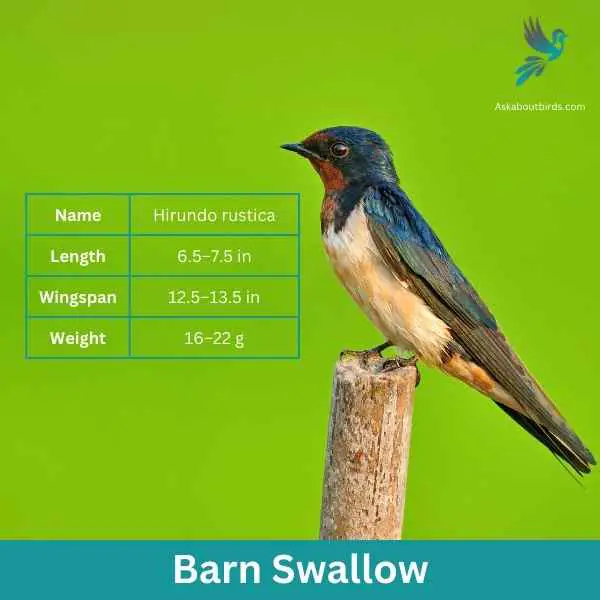

| Feature | Measurement |
|---|---|
| Scientific Name | Hirundo rustica |
| Length | 6.5–7.5 in |
| Wingspan | 12.5–13.5 in |
| Weight | 16–22 g |
The Barn Swallow is a sleek, agile bird renowned for its graceful flight patterns and iconic forked tail, often seen darting over fields and water bodies in search of flying insects.
Appearance: Barn Swallows have deep blue, almost iridescent, upperparts and a rufous to tawny underbelly. Their distinctively forked tail and long wings give them a streamlined look. Both males and females have a similar appearance, though males often exhibit slightly brighter colors and a deeper fork in the tail.
Diet: Barn Swallows feed primarily on flying insects, which they catch in mid-air during their agile and acrobatic flights. Their diet includes flies, beetles, moths, and other small flying insects.
Reproduction: Barn Swallows are known for building their mud nests on man-made structures, particularly barns, bridges, and eaves. The nest is cup-shaped and made from mud pellets, often lined with feathers. The female lays a clutch of 4 to 6 eggs.
Eastern Bluebird
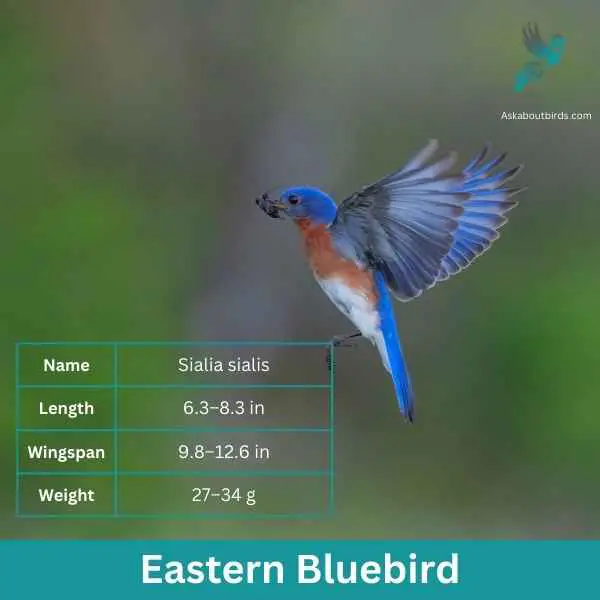
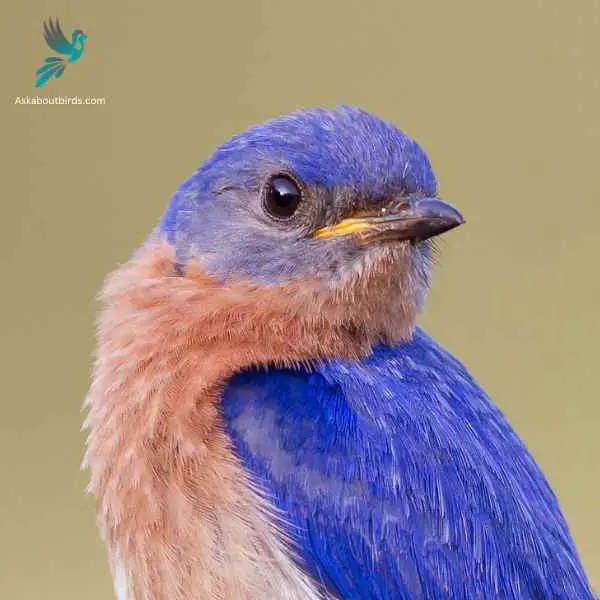
| Feature | Measurement |
|---|---|
| Scientific Name | Sialia sialis |
| Length | 6.3–8.3 in |
| Wingspan | 9.8–12.6 in |
| Weight | 27–34 g |
The Eastern Bluebird (Sialia sialis) is a small thrush found in open woodlands, farmlands, and orchards, and is recognized for its vibrant blue and red coloration. Male Eastern Bluebirds are dazzling with bright blue upperparts and a rusty or brick-red throat and breast, while females, though less colorful, still offer a similar pattern. The bird is native to North America and is commonly seen east of the Rockies, from Canada to the Gulf States and southeastern Arizona to Nicaragua.
Eastern Bluebirds feed on insects, wild fruit and berries. They have a gentle nature and are often seen perched alone or in small groups in the open, scanning the ground for prey. They are cavity nesters and will use old woodpecker holes or birdhouses if they are the right size.
Mountain Bluebird
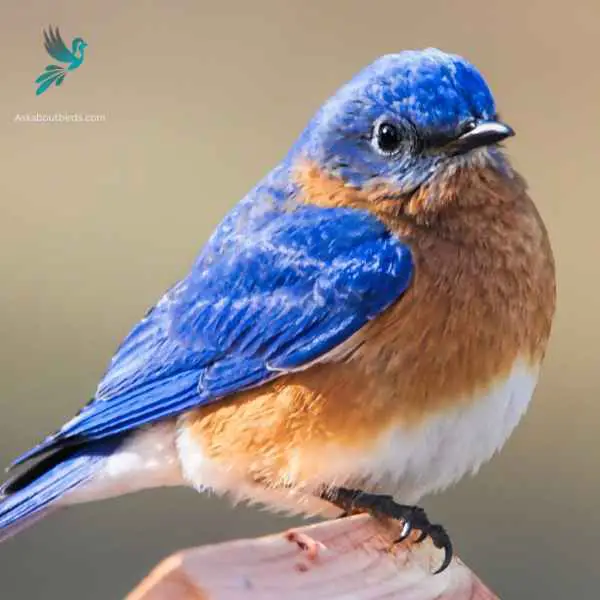
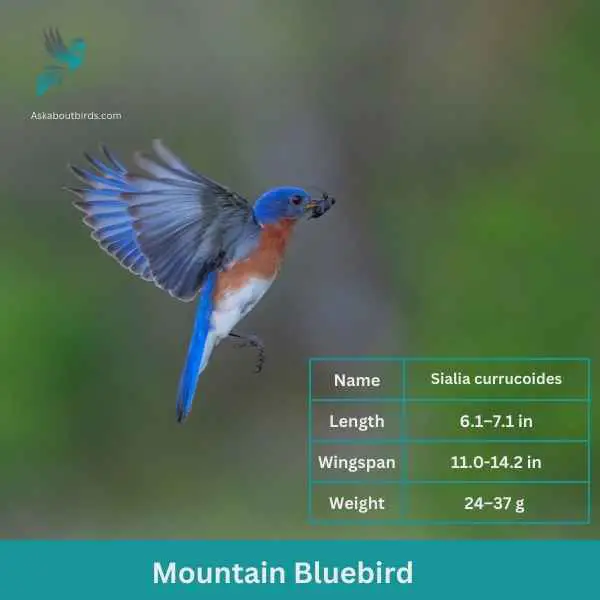
| Feature | Measurement |
|---|---|
| Scientific Name | Sialia currucoides |
| Length | 6.1–7.1 in |
| Wingspan | 11.0-14.2 in |
| Weight | 24–37 g |
The Mountain Bluebird is a small bird found in open grasslands and rocky mountains of North America. It is known for its stunning blue plumage, which is particularly vibrant in males. Females, on the other hand, have a more subdued blue coloration with hints of gray. These birds have slender bodies and a slightly curved bill, adapted for catching insects on the wing.
Mountain Bluebirds are insectivores, feeding primarily on insects such as beetles, grasshoppers, and spiders. They are skilled aerial hunters, capable of capturing their prey in mid-flight. During breeding season, these birds build their nests in tree cavities or man-made nest boxes, where females lay a clutch of eggs. The male bluebird actively participates in nest-building and provides food for the female during incubation.
Western Bluebird
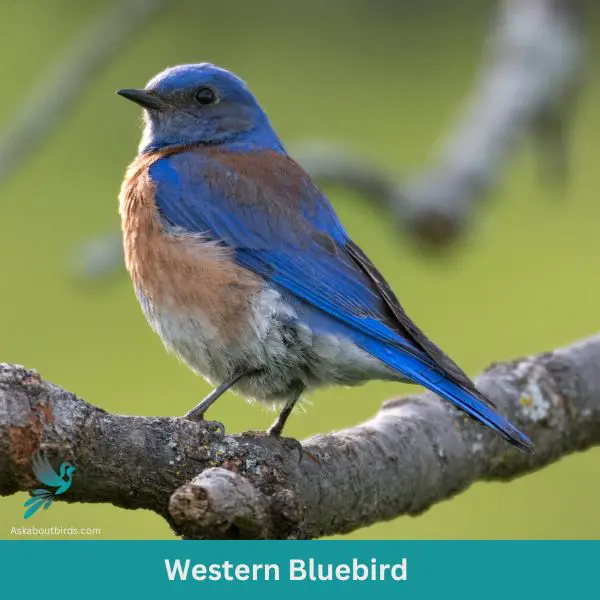
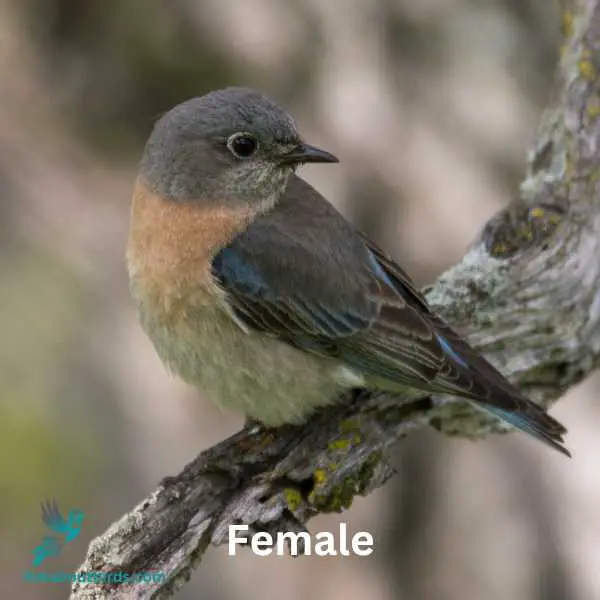
| Trait | Western Bluebird |
|---|---|
| Scientific Name | Sialia mexicana |
| Length | 5.5-7 inches |
| Wingspan | 11-13 inches |
| Weight | 0.8-1.1 ounces |
The Western Bluebird is a charismatic bird, appreciated for its vivid coloring and melodious song, commonly observed in open woodlands and meadows of the West.
Appearance: The male Western Bluebird sports a dark blue head, throat, wings, and tail with an orange breast and sides, transitioning into a grayish belly. Females are more muted, displaying grayish-blue wings and tail with a more subdued orange wash on the chest.
Diet: Western Bluebirds predominantly feed on insects, complemented by berries and fruits when available. They hunt by perching and then diving to the ground to capture their prey, and they’re also known to catch insects in mid-air.
Reproduction: These birds often utilize natural tree cavities or nest boxes for breeding. The female builds a loose nest inside and lays a clutch of 4-6 pale blue eggs.
Indigo Bunting


| Feature | Measurement |
|---|---|
| Scientific Name | Passerina cyanea |
| Length | 4.5–5.1 in |
| Wingspan | 7.1–9.1 in |
| Weight | 11.2–21.4 g |
The Indigo Bunting is a strikingly vibrant songbird, often hailed for its brilliant blue plumage and melodic song that graces woodlands and meadows during the warmer months.
Appearance: Males are renowned for their bright indigo blue feathers, which can appear darker in certain lights. Females and juveniles, on the other hand, are brown with subtle hints of blue on their wings and tail. The species lacks the vibrant streaking or spotting commonly found in many other songbirds.
Diet: Indigo Buntings primarily subsist on seeds, especially during non-breeding seasons. During the breeding season, they also consume a variety of insects such as beetles, caterpillars, and spiders, providing essential protein for their growing chicks.
Reproduction: Indigo Buntings build their nests close to the ground in shrubs or low tree branches. These nests, crafted meticulously with grasses and other plant materials, cradle clutches of typically 3 to 4 eggs. After hatching, the young are fed by both parents until they’re ready to fledge.
Blue Jay
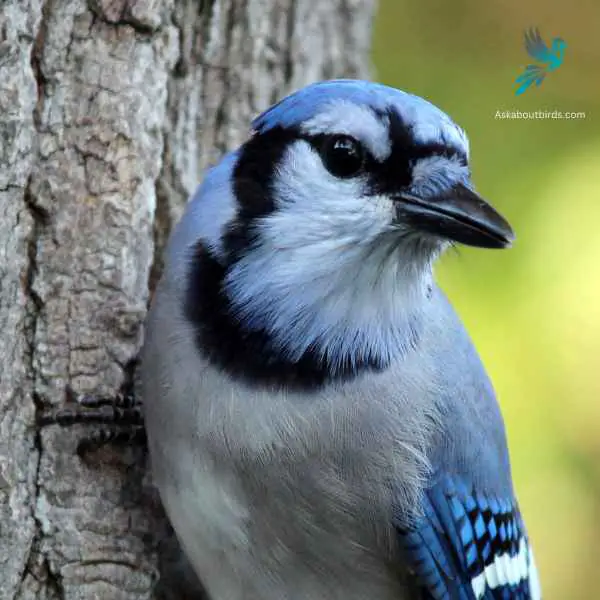
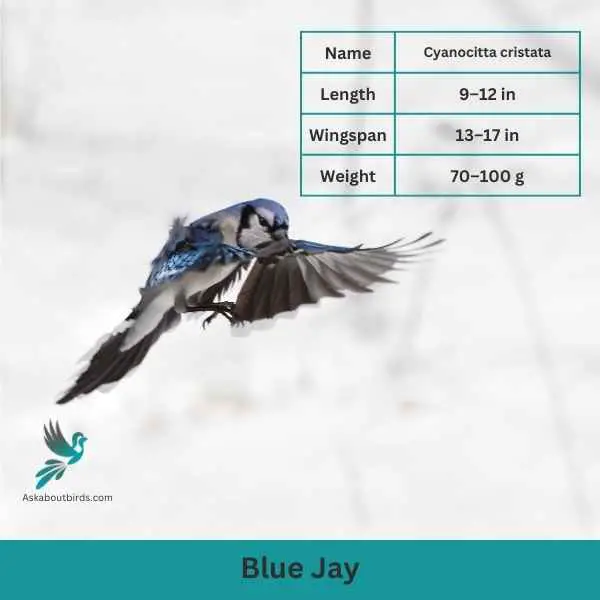
| Feature | Measurement |
|---|---|
| Scientific Name | Cyanocitta cristata |
| Length | 9–12 in |
| Wingspan | 13–17 in |
| Weight | 70–100 g |
The Blue Jay is a vibrant and easily recognized bird, known for its intelligence, distinctive calls, and bold behavior, commonly found throughout the eastern and central United States.
Appearance: The Blue Jay sports a striking blue upper body with white and black markings. Its face has a pronounced white patch with a black necklace that runs across the throat and around the head. The bird also features a pronounced blue crest, which can be raised or lowered, and its wings and tail are brightly colored with black bars and white tips.
Diet: Blue Jays are omnivores. Their diet consists primarily of seeds, nuts, especially acorns, fruits, and small insects. They’ve also been known to eat eggs or nestlings of other birds occasionally. Blue Jays often store food items in caches to eat later.
Reproduction: Blue Jays are monogamous birds that form long-lasting pair bonds. They typically build their nests in trees or large shrubs, constructing them from twigs, grass, and sometimes using mud as a binder. The female lays a clutch of 3 to 6 eggs, which are pale blue or sometimes white with brown speckles.
Blue Grosbeak
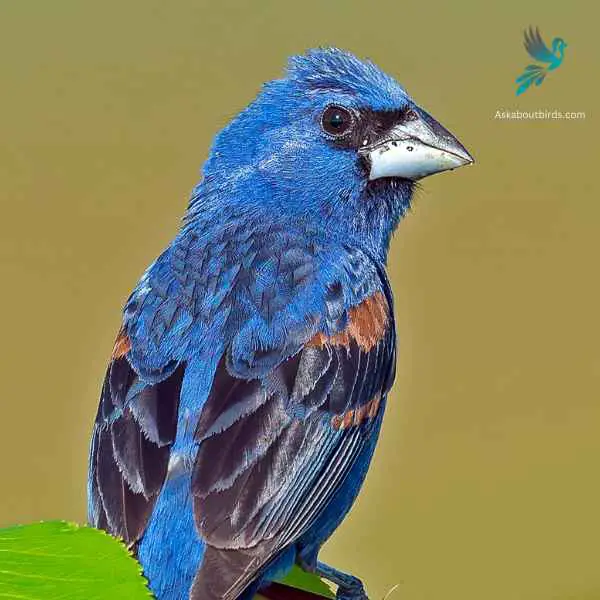
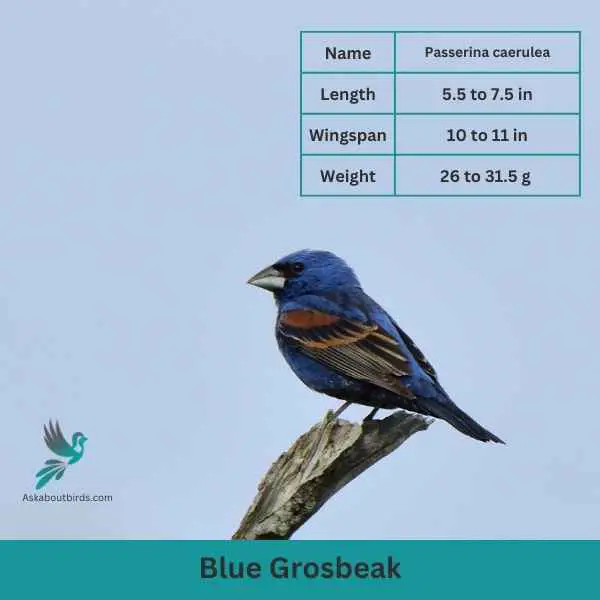
| Feature | Measurement |
|---|---|
| Scientific Name | Passerina caerulea |
| Length | 5.5 to 7.5 in |
| Wingspan | 10 to 11 in |
| Weight | 26 to 31.5 g |
The Blue Grosbeak is a medium-sized songbird found in North and Central America. The male Blue Grosbeak displays stunning plumage with deep blue feathers on its body and head, while the female has more subdued brownish tones. Both sexes have a thick, conical bill, which gives them their name “grosbeak,” meaning large beak.
These birds prefer open habitats such as grasslands, brushy areas, and woodland edges. Blue Grosbeaks are known for their melodious songs, which consist of a series of rich and varied notes. They primarily feed on seeds and insects, using their strong beaks to crack open seeds and forage on the ground or in low vegetation.
Blue-headed Vireo
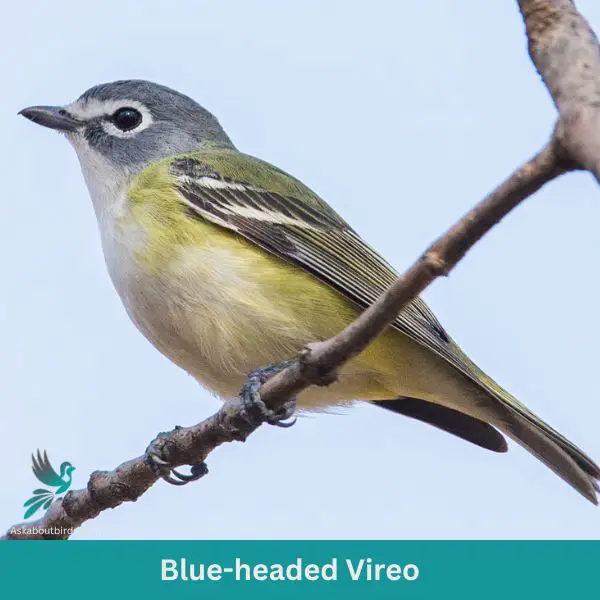
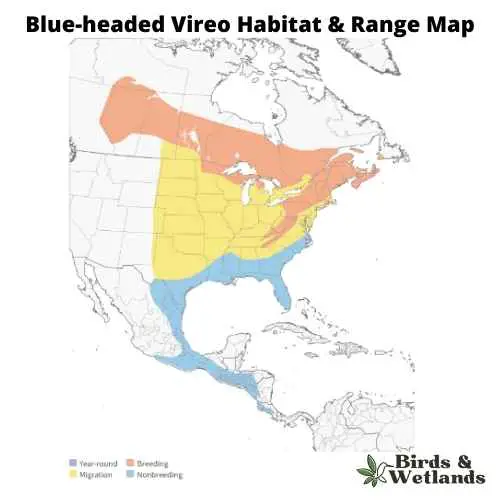
| Trait | Blue-headed Vireo |
|---|---|
| Scientific Name | Vireo solitarius |
| Length | 5-5.5 inches |
| Wingspan | 7.9-9.8 inches |
| Weight | 0.4-0.6 ounces |
The Blue-headed Vireo is a songbird recognized for its sharp and clear song as well as its distinct coloration.
Appearance: It has a blue-gray head and nape, contrasting sharply with its white throat and belly. A white eye ring combined with two white wing bars and yellowish flanks further accentuate its appearance.
Diet: The Blue-headed Vireo feeds mainly on insects and spiders. It often forages in the forest canopy, picking prey off leaves and twigs.
Reproduction: The female constructs a cup-shaped nest made of twigs, bark, and spiderwebs, often placed in the fork of a tree branch. Typically, she lays a clutch of 3-5 eggs. Both parents share the responsibility of incubating the eggs and feeding the chicks.
Blue-winged Warbler
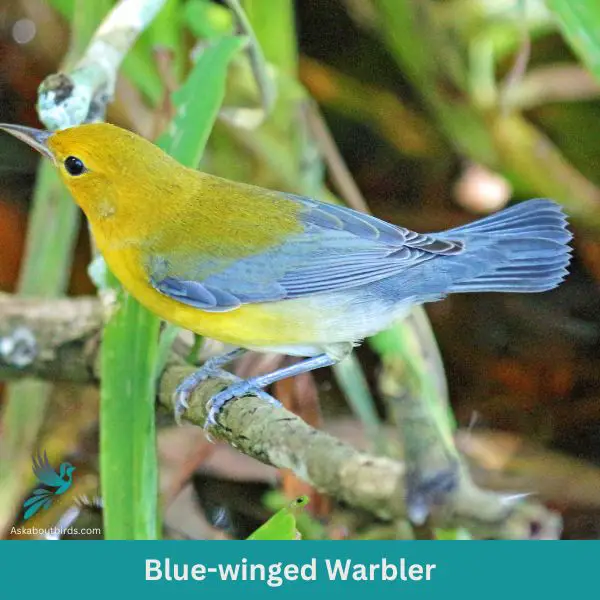
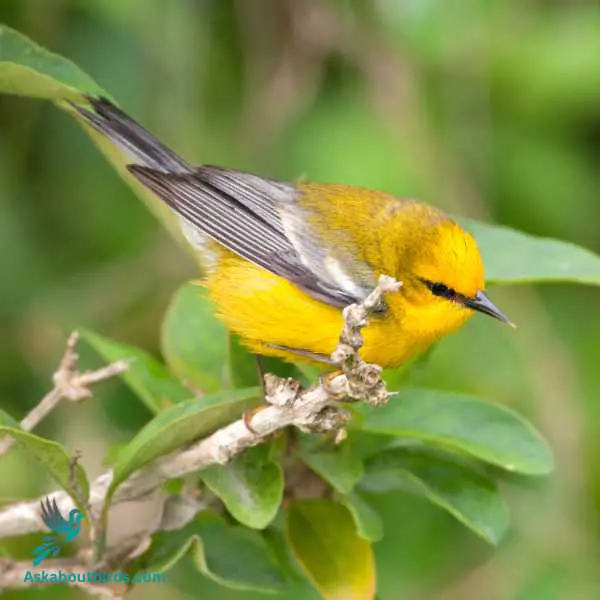
| Trait | Blue-winged Warbler |
|---|---|
| Scientific Name | Vermivora cyanoptera |
| Length | 4.3-4.7 inches |
| Wingspan | 6.7-7.5 inches |
| Weight | 0.3-0.4 ounces |
The Blue-winged Warbler is a vibrant songbird that stands out with its lemon-yellow coloring and buzzing song.
Appearance: This warbler displays a brilliant yellow body contrasted by blue-gray wings and a slim, black line through the eyes. The wings also feature two white wing bars.
Diet: The diet of the Blue-winged Warbler primarily consists of insects and spiders. They actively forage in shrubs and low trees, picking off their prey from the foliage.
Reproduction: Blue-winged Warblers build their nests on or near the ground, using grasses and other fine materials. The female lays a clutch of 4-6 eggs, which she incubates.
Cerulean Warbler
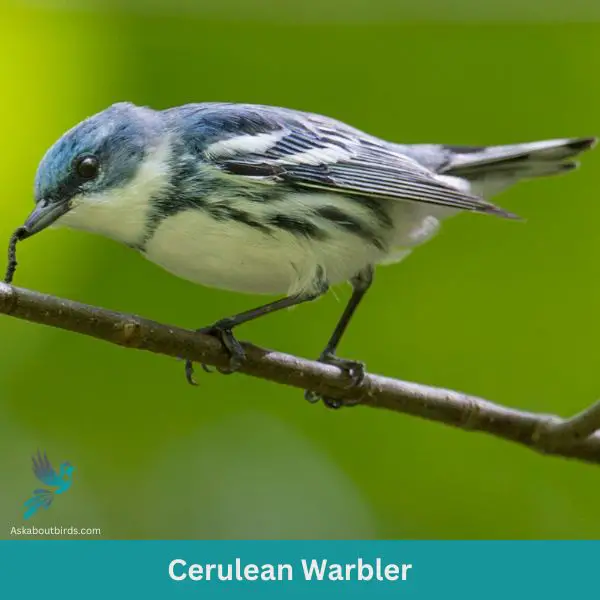
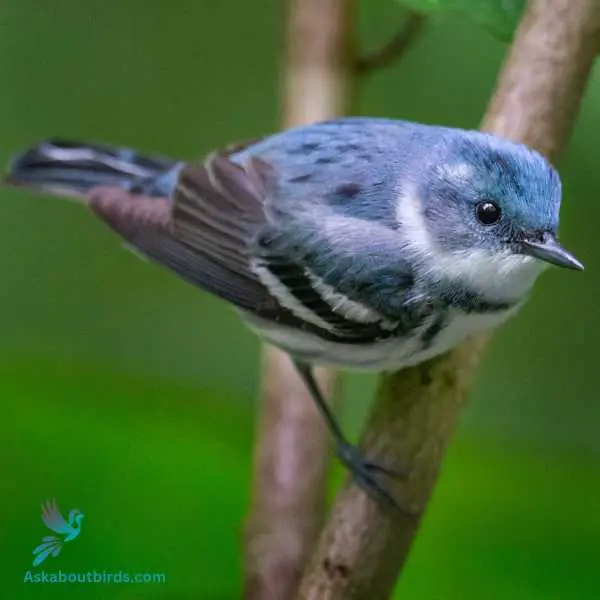
| Trait | Cerulean Warbler |
|---|---|
| Scientific Name | Setophaga cerulea |
| Length | 4.5 inches |
| Wingspan | 7.9-8.7 inches |
| Weight | 0.3-0.4 ounces |
The Cerulean Warbler is a striking songbird known for its sky-blue plumage and flitting movements in the forest canopy.
Appearance: Males boast a vibrant cerulean blue color on their upperparts, with streaked underparts, and a black necklace. Females have a more subdued bluish-green hue and lack the prominent black markings seen in males.
Diet: The diet of the Cerulean Warbler is predominantly made up of insects and spiders. They actively forage high in the treetops, gracefully maneuvering through leaves and branches.
Reproduction: Cerulean Warblers nest in the upper branches of tall deciduous trees. The female weaves a shallow cup-shaped nest and lays a clutch of 3-5 eggs.
Where to Spot New York’s Blue Birds
New York State is home to an array of bird species, making it a must-visit for avid bird watchers. Below are some of the top locations in New York where you can find the greatest diversity of birds:
- Central Park, New York City: This iconic park is not just a haven for city dwellers, but also for a wide variety of birds. Over 200 bird species have been spotted here, making it an ideal spot for bird watching in the heart of the city.
- Montezuma National Wildlife Refuge: Located at the north end of Cayuga Lake in the Finger Lakes Region, this refuge provides a resting, feeding, and nesting habitat for waterfowl and other migratory birds.
- Shawangunk Grasslands National Wildlife Refuge: Formerly an airport, this area has been restored to grassland, providing a habitat for grassland birds, many of which are declining in numbers.
- Mashomack Preserve, Shelter Island: This 2,039-acre preserve on Shelter Island is often referred to as the “Jewel of the Peconic” and is home to a wide variety of bird species.
- Jamaica Bay Wildlife Refuge, Queens: This refuge in Queens, New York City, is one of the most important urban wildlife refuges in the United States, featuring various bird species, including migratory birds.
| Neighboring State’s Blue Birds | Best Spots for Blue Birds |
|---|---|
| New Jersey’s Blue Birds | 1. Great Swamp National Wildlife Refuge 2. Cape May Point State Park 3. Edwin B. Forsythe National Wildlife Refuge |
| Pennsylvania’s Blue Birds | 1. Presque Isle State Park 2. Hawk Mountain Sanctuary 3. Middle Creek Wildlife Management Area |
| Vermont’s Blue Birds | 1. Green Mountain National Forest 2. Dead Creek Wildlife Management Area 3. Missisquoi National Wildlife Refuge |
| Massachusetts’s Blue Birds | 1. Parker River National Wildlife Refuge 2. Plum Island 3. Quabbin Reservoir |
| Connecticut’s Blue Birds | 1. Hammonasset Beach State Park 2. White Memorial Conservation Center 3. Bent of the River Audubon Center |
